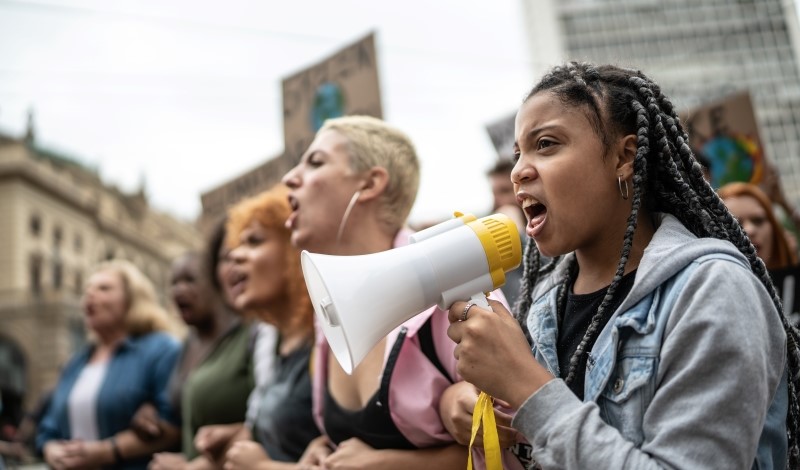
Scholars assess regulations affecting youth rights and offer guidance to promote youth civic participation.
In the United States, one in five individuals has limited legal voice under the law. They are people under the age of 18—and their lives are just as affected by laws as adults’.
In a recent article, Jonathan Todres, a professor at Georgia State University College of Law, Charlene Choi, policy and sustainability principal analyst at All Children Thrive California, and Joseph Wright, a PhD candidate in education at the University of California, Los Angeles, use a children’s rights framework to argue that regulators must view children as rights holders in the United States to create more opportunities for meaningful civic participation. Todres and his coauthors propose models of meaningful participation beyond voting to broaden civic engagement for young people.
Todres and his coauthors look beyond voting rights to note four other areas where legislation impacts children’s civic engagement: laws that deny children rights; laws that restrict children’s rights; laws that create barriers for children’s participation in democracy; and laws that give children equal rights with adults.
Regulators deny children opportunities for civic engagement based on their age. Beyond limiting the ability to vote based on age, many government positions have minimum ages for eligibility. Children can neither choose their government representatives nor can they serve in a majority of government positions themselves.
In addition, many laws limit children’s abilities to exercise constitutional rights. Todres and his coauthors suggest that laws that impose curfews on young people may limit their right to assemble for civic purposes. Similarly, they posit that laws that restrict student speech in schools limit children’s freedom of expression.
Todres and his coauthors also argue that some laws impose “indirect barriers to youth participation.” For example, child labor laws limit children’s abilities to earn an income and may keep them from having the economic power sometimes necessary for persuasive civic engagement.
Although many regulations negatively affect children’s rights, Todres and his coauthors concede that some laws allow children to share the same rights as adults. For example, children are counted in the census, which determines the apportionments in the House of Representatives. Furthermore, children are not restricted if they wish to communicate with representatives about issues that concern them.
The authors center their proposals for greater youth participation in the realm of international children’s rights law. The robust international children’s rights treaty, the Convention on the Rights of the Child (CRC), explains that although parents can represent children’s interests, children should have agency.
Under the CRC, lawmakers can choose how they weigh a child’s perspective in their decision making. The CRC maintains that while children have the right to be heard, lawmakers are not required to allow children to be final decisionmakers so long as they take the children’s views seriously. Lawmakers can ensure children engage in meaningful participation through these steps.
Todres and his coauthors contend that beyond the legal mandates of the CRC, lawmakers should use the “Lundy Model,” created by Laura Lundy, a professor of children’s rights at Queen’s University, to assess whether a policy is promoting children’s participation rights.
The Lundy Model provides elements that constitute various aspects of the children’s rights enumerated in the CRC. For example, the right to be heard is measured based on “space, voice, audience, and influence.” To satisfy these elements, children must be given the space to express their opinions and the opportunity to be heard and taken seriously.
The authors argue that policymakers must establish interventions that follow the Lundy Model to encourage further meaningful youth participation. They name three main forms of participation interventions: consultive; collaborative; and youth-led.
They encourage lawmakers to engage with young people as consultants in their work by asking them about their experiences with different issues. Lawmakers can then incorporate these comments as they create policy.
Todres and his coauthors also suggest that policymakers collaborate with youth by having young people partner with adults by joining advisory councils and research projects on different policy initiatives.
They propose that regulators implement youth-led participation programs where young people identify the issues that they want to explore and adults serve as facilitators. Some recent youth-led movements include the Sunrise Movement and March for Our Lives. They argue that implementing programs that specifically focus on children’s interests will allow children’s rights to be further mainstreamed.
Regulators at local and national levels should also hold special sessions for young people to participate in their proceedings, the authors argue, along with the establishment of federal government authorities, such as a White House Office on Children, to ensure that children’s issues are taken seriously.
It is also important for state and local agencies to hire youth-focused professionals, they argue. These agencies extend beyond education and child welfare to include issues such as those concerning transportation and city planning.
Todres and his coauthors concede that there are barriers to meaningful youth participation. Obstacles, including financial barriers, which may make it hard for some young people to attend youth participation programming, and the hesitation by adults to listen to young people, may hinder progress.
Policymakers can, however, use regulation as a tool to ensure that children have greater opportunities for more meaningful participation in the United States. Regulators can give a voice back to the 20 percent of the country’s population that has been excluded from the democratic process by creating spaces, platforms, and positions that serve to emphasize youth rights and civic engagement.



